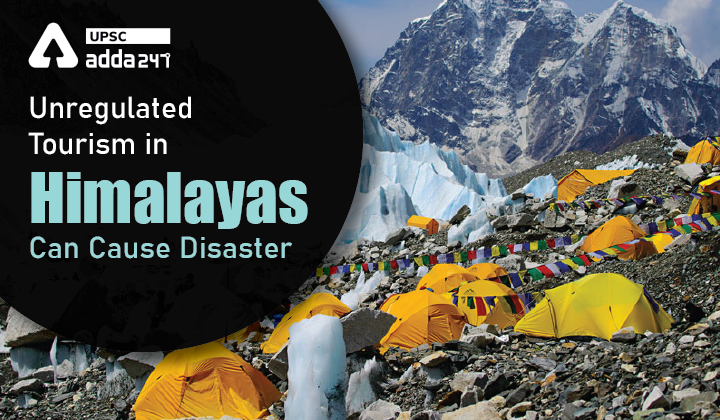Table of Contents
Tourism in Himalayas UPSC: Relevance
- GS 3: Conservation, environmental pollution and degradation, environmental impact assessment.
Tourism in Himalayan region: Context
- According to a recently published report, unregulated tourism in the Himalayas is causing a mountain of problems for the ecologically sensitive region.
Tourism destroying Himalayas: Key points
- The report titled Environmental assessment of tourism in the Indian Himalayan region has been prepared by Govind Ballabh Pant National Institute of Himalayan Environment and was submitted to Union Ministry of Environment, Forest and Climate Change (MoEF&CC) in compliance with the National Green Tribunal (NGT) order.
- The report has said that there is a need to pre-empt the disastrous effects of unregulated tourism and learn lessons from the over-exploited tourist destinations in the Himalayan region.
- The report has also highlighted that demand for tourism has increased pressure on hill stations and is becoming a major concern for change in land use and land cover.
Increasing tourism in Himalayan region
- Tourism in Ladakh: Water deficient region: Ladakh is a water deficient region, which is mostly dependent on snow / glacial melt and flow of River Indus. Here, individual water consumption by a resident is 75 litres per day on an average, whereas a tourist consumes about 100 l / day.
- Built-up area in Himachal Pradesh increased from 4.7 per cent to 15.7 per cent during 1989-2012, and the number of tourists in the region also swelled to 2.8 million from 140,000 from 1980-2011.
- The number of hotels also increased over the years, indicating a loss of greenery and biodiversity in the region.
Sustainable tourism in Himalayas: Recommendations
- Vigilance and patrolling: Protected areas in Ladakh like Hemis National Park, Changthang Cold Desert Sanctuary and Karakoram Sanctuary require vigilance and regular patrolling to reduce unwanted wildlife-tourist interaction as well as habitat destruction due to off-road driving and encroachment
- Monitoring of carrying capacity: Prior monitoring of carrying capacity in terms of tourist inflow of vehicles, air quality and solid waste management largely in the Kashmir region, or pilgrims visiting the holy cave of Amarnath and Vaishno Devi in Jammu need to be done to ensure quality tourism.
- Establishment of regulated tourism practices with promotion of sustainable agendas is required for the Indian Himalayan region (IHR), which can be achieved through maintenance of proper tourist capacity in every tourist place of the IHR.
- This can also help in minimising the generation of solid waste and pollution level in the water, air and destruction of biodiversity.
Read current affairs for UPSC



 TSPSC Group 1 Question Paper 2024, Downl...
TSPSC Group 1 Question Paper 2024, Downl...
 TSPSC Group 1 Answer key 2024 Out, Downl...
TSPSC Group 1 Answer key 2024 Out, Downl...
 UPSC Prelims 2024 Question Paper, Downlo...
UPSC Prelims 2024 Question Paper, Downlo...





